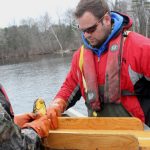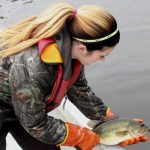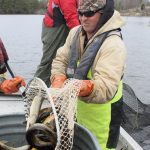Lake surveys underway on local waters
By Greg Seubert
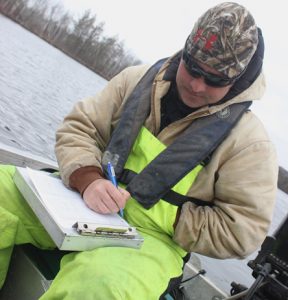
Most anglers wouldn’t be impressed with a 6- or 7-inch black crappie.
Several of them turned up in a fyke net April 22 during a fish survey of Waupaca County’s School Section Lake, a 39-acre body of water a few miles northwest of Manawa.
Although three nets the state Department of Natural Resources placed in the lake yielded more than 200 fish – most of them yellow or black bullhead – DNR fisheries technician Elliot Hoffman was surprised with the number of crappie that turned up.
“They’re littler fish, but after the fish kill we had here two or three years ago, it’s nice to see they pulled off a hatch and it looks like they’re making a comeback,” said Hoffman, who checked out the nets with DNR fisheries technician Joe Dax and Fox Valley Technical College natural resources student Shyann Nieland of Seymour.
Most of the crappie – including one that measured nearly 11 inches – came out of the final net the crew visited.
“I was shocked to see that many,” Hoffman said. “This has always been a very good black crappie lake, but with the dieoff, it’s nice to see there’s a lot of fish in here. I’m guessing they’re 2 to 3 years old. They’re smaller, but they’ll grow.”
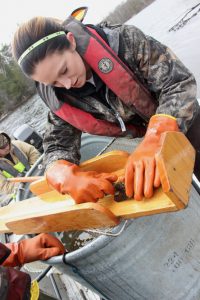
Besides the crappie and bullhead, the nets also captured a few northern pike and small bluegill, a 17-inch-long largemouth bass and a large snapping turtle.
Dax and Nieland netted, measured and released each fish while Hoffman recorded the species and length.
The study is part of the state’s new panfish management plan. School Section is one of nearly 100 lakes around Wisconsin with experimental regulations. The lake’s daily bag limit for panfish remains at 25, but as of April 1, anglers cannot keep more than 10 of any species (bluegill, crappie, perch).
“We’re trying to gauge whether the fish are fast- or slow-growing and the average size of black crappie and bluegill in this survey,” Hoffman said. “What we’ve been catching is a pretty typical catch and we really haven’t seen anything out of the ordinary.”
DNR crews conducted a one-day boomshocking survey of the lake last spring to collect data before the new regulations took effect.
“The bluegill population looked really well,” Hoffman said. “They were probably averaging 6 inches.”
The DNR is conducting studies this spring on a number of the special regulation lakes, including White and Stratton in Waupaca County.
White Lake is a 1,064-acre lake between Weyauwega and Manawa with the same new regulation as School Section.
“The size structure on White looked really good for bluegill, which you’d expect,” Hoffman said. “With the large bluegill in there and the potential for them to get really large, their growth is really fast. With the fishing pressure so high, we’d like to see if this reduced bag limit would increase the average size out there. Even though they are nice fish, we think there is potential for them to get even bigger.”
Nieland will graduate from FVTC in May with an associate degree in natural resources.
“It’s very diverse in what we get to learn,” she said. “We do wastewater, water quality, forestry, wildlife, fisheries, surveying, soils. You get a pretty good introduction to it all. Then, you can go to Stevens Point or different colleges around the area and get a bachelor’s degree.
“I chose it because I’ve always been passionate about the outdoors,” she added. “It’s a program where you get to see the difference that you make. You can go plant a tree and watch it grow.”

